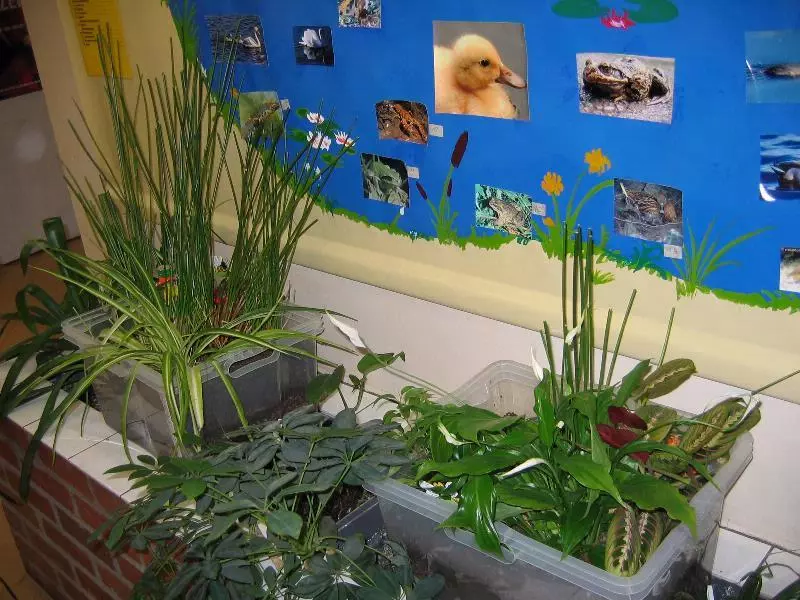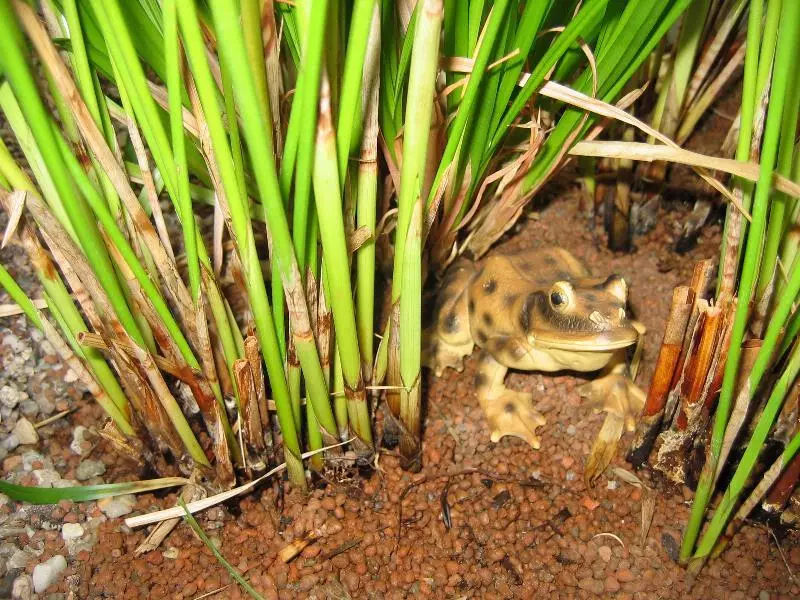Constructing a wetland model
A constructed wetland is a nature-orientated technology to treat wastewater. The following construction manual allows pupils to build their own treatment plant. Pupils get an understanding of the set-up of a constructed wetland and the way it works. They realize that constructed wetlands are a modern ecological technology, where principles of nature are used to clean wastewater. They conduct experiments to follow up the cleaning capacity of their treatment plant.
Learning goals
- The pupils will get an understanding of the set-up of a constructed wetland and the way it works.
- The pupils learn that constructed wetlands are a simple technology, where principles of nature are used to clean wastewater (soil filter, degradation, plant uptake).
- The pupils will build the model themselves and handle technical equipment. Thus, they will get an insight into the practical work of engineers and scientists.
Background information
Wetlands are found in a variety of places along rivers and lakes, in low lying woods or fields and in manmade low spots where water is collected. Wetlands have qualities of both aquatic and terrestrial ecosystems or in other words: wetlands are neither lakes nor rivers but also not solid ground.
The ability of wetlands to store water makes them valuable as water source and habitat for a variety of plants and animals. Wetlands are biologically very active and an important factor for the self-purification capacity of the water cycle.
The processes occurring in soils, rivers and streams are called «self-purification». They are mainly due to tiny organisms (mostly bacteria and other unicellular organisms) that live in the soil or the water and have the ability to degrade pollutants and turn them into harmless substances. The soil matrix also functions as filter and the plant roots form a perfect filtration network, which retains dirt particles and pathogens. Furthermore the plant roots increase the oxygen transfer into the soil body and thereby support the bacteria that need oxygen to degrade the pollutants.
Constructed wetlands are the result of ecological engineering and represent an alternative technology to conventional sewage works. The technology is able to eliminate a variety of wastewater components (excess nutrients, toxic substances, and pathogens) and generate treated water, which can be reused e.g. in arid regions as irrigation water. Because of their relatively low construction and operation costs, these ecotechnology systems have a broad application spectrum, covering even rural regions with low infrastructure and countries with low economic resources.
Time requirement
- Preparation time: 2-3 hours (incl. shopping)
- Teaching time: 1.5 hours
Material requirement
- 1 transparent plastic box 35*23*31cm
- 15 kg of gravel 4-16mm
- 25 litre of expanded clay (LECA) 1-4 mm
- 2 plastic buckets (10 litres)
- 25 cm transparent plastic hoses, diameter 20 mm
- 1 plastic water tap (with screw and nut)
- 1 measure cup 1 litre
- 1 measuring tape (tailor)
- 1 roll adhesive tape
- plants: e.g. indoor plants,
Umbrella Papyrus (Cyperus alternifolius), rush (Juncus spec.) - additional equipment (scissors, pen, sponge, towel, paper, etc.)
Let's start
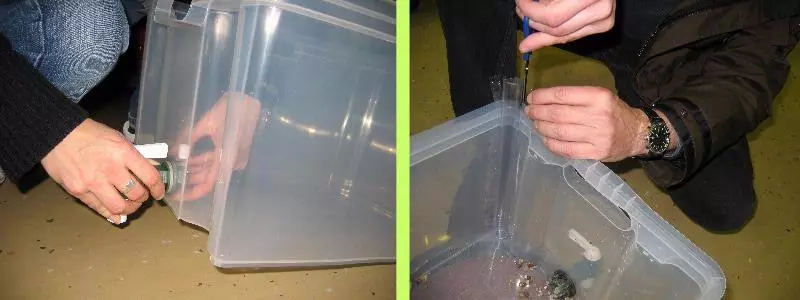
1. Pierce one hole of the size of the tap into the narrow side of the box. The hole should be located centrally and 2 cm above the bottom (should be prepared by the teacher).
2. Install the plastic tap and tightly fix the plastic nut. Make sure that the connection is waterproof.
3. Fix the transparent plastic hose in a corner of the box.
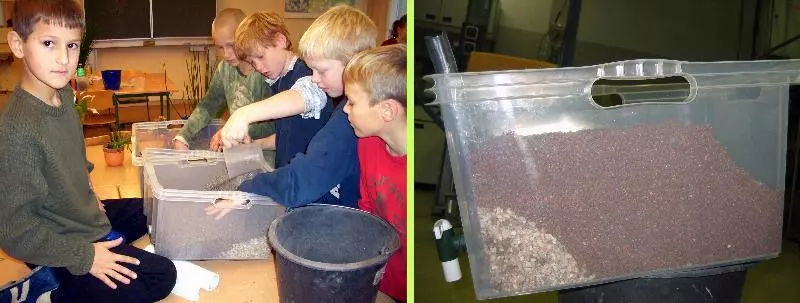
4. Lift one end of the box as shown in the figure above and fill in first gravel, then the expanded clay.
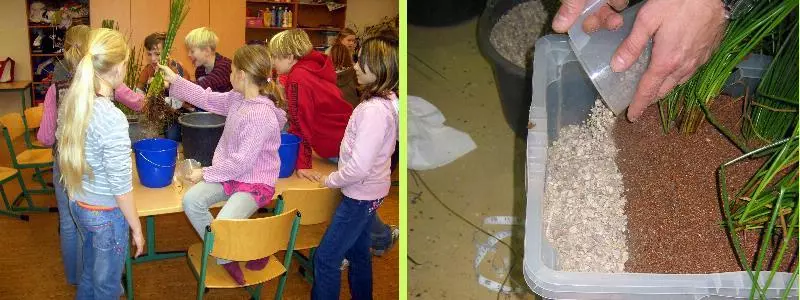
5. Remove the pots from the plants and carefully take away most of the soil from the roots. Implant the indoor plants (pupils brought along) or the Umbrella Papyrus in the expanded clay (be careful with roots).
6. Finally fill in gravel and form the inlet (inflow filter) of the treatment plant.
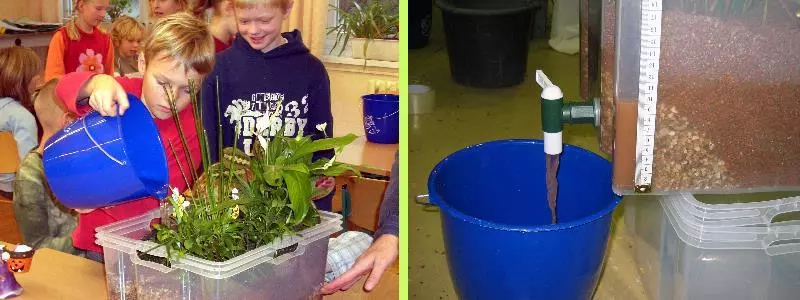
7. Fix the measuring tape next to the plastic hose at the outside of the box.
8. Place the wetland at a safe place, put bucket below the outlet slowly pour approximately 5 L of water to the inlet of the system. Use measuring cup. If the outlet water is turbid, repeat the procedure until the out-flowing water is clear.
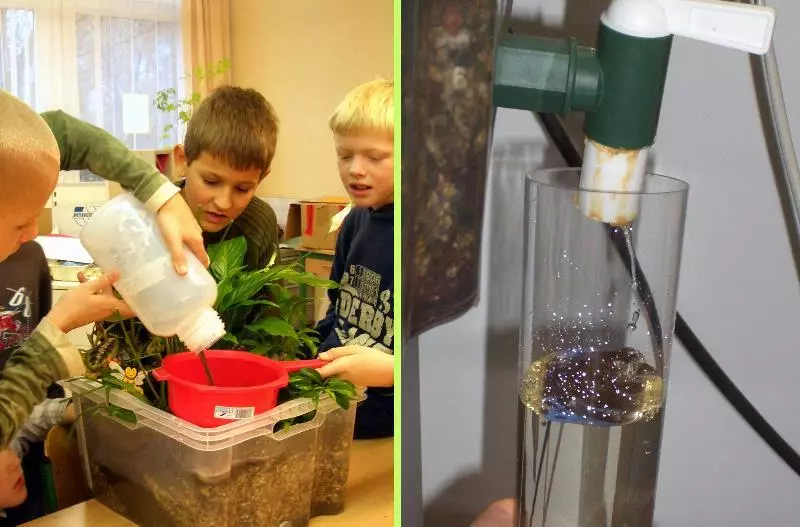
9. Pour 1 L of artificial wastewater into the system and fill up with clean water to a water level of 10 cm.
10. Take a water sample once a week and «analyse» the water quality as described in the experiment «Wastewater analysis».
11. After taking the water sample, once a week pour 1 L of artificial wastewater into the system and fill up with clean water to a water level of 10 cm.
See and feel
- Observe the growth of the plants
- Observe the growth of the roots
- Measure the water level twice a week
- Analyse the water quality once a week.
Didactical comments
Show pupils pictures, slides or a short video clip of wetlands and constructed wetland. Ask students to describe why these areas are called wetlands and what differences exist between wetlands and traditional wastewater treatment systems. Work out «cleaning mechanisms» such as filtration, sedimentation, evapotranspiration, biodegradation.
